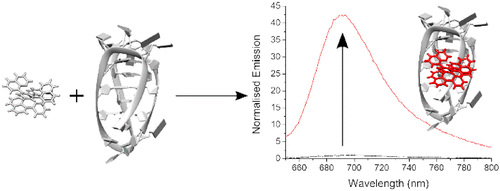当前位置:
X-MOL 学术
›
J. Am. Chem. Soc.
›
论文详情
Our official English website, www.x-mol.net, welcomes your feedback! (Note: you will need to create a separate account there.)
Beyond Solvent Exclusion: i-Motif Detecting Capability and an Alternative DNA Light-Switching Mechanism in a Ruthenium(II) Polypyridyl Complex
Journal of the American Chemical Society ( IF 15.0 ) Pub Date : 2020-08-04 , DOI: 10.1021/jacs.0c04789 Philip Spence , John Fielden , Zoë. A. E. Waller
Journal of the American Chemical Society ( IF 15.0 ) Pub Date : 2020-08-04 , DOI: 10.1021/jacs.0c04789 Philip Spence , John Fielden , Zoë. A. E. Waller

|
Cytosine-rich DNA can fold into secondary structures known as i-motifs. Mounting experimental evidence suggests that these non-canonical nucleic acid structures form in vivo and play biological roles. However, to date, there are no optical probes able to identify i-motif in the presence of other types of DNA. Herein, we report for the first time the interactions between the three isomers of [Ru(bqp)2]2+ with i-motif, G-quadruplex, and double-stranded DNA. Each isomer has vastly different light-switching properties: mer is "on", trans is "off", and cis switches from "off" to "on" in the presence of all types of DNA. Using emission lifetime measurements, we show the potential of cis to light up and identify i-motif, even when other DNA structures are present using a sequence from the promoter region of the death-associated protein (DAP). Moreover, separated cis enantiomers revealed Λ-cis to have a preference for the i-motif, whereas Δ-cis has a preference for double-helical DNA. Finally, we propose a previously unreported light-switching mechanism that originates from steric compression and electronic effects in a tight binding site, as opposed to solvent exclusion. Our work suggests that many published non-emissive Ru complexes could potentially switch on in the presence biological targets with suitable binding sites, opening up a plethora of opportunity in the detection of biological molecules.
中文翻译:

超越溶剂排除:i-Motif 检测能力和钌 (II) 多吡啶复合物中的替代 DNA 光开关机制
富含胞嘧啶的 DNA 可以折叠成称为 i-motifs 的二级结构。越来越多的实验证据表明,这些非经典核酸结构在体内形成并发挥生物学作用。然而,迄今为止,还没有能够在其他类型 DNA 存在的情况下识别 i-motif 的光学探针。在此,我们首次报道了 [Ru(bqp)2]2+ 的三种异构体与 i-motif、G-四链体和双链 DNA 之间的相互作用。每种异构体都具有截然不同的光开关特性:在所有类型的 DNA 存在的情况下,mer 为“on”,trans 为“off”,而 cis 从“off”切换为“on”。使用发射寿命测量,我们展示了 cis 点亮和识别 i-motif 的潜力,即使使用来自死亡相关蛋白 (DAP) 启动子区域的序列存在其他 DNA 结构。此外,分离的顺式对映体显示 Λ-cis 偏爱 i-motif,而 Δ-cis 偏爱双螺旋 DNA。最后,我们提出了一种以前未报道的光开关机制,它源于紧密结合位点的空间压缩和电子效应,而不是溶剂排斥。我们的工作表明,许多已发表的非发射 Ru 复合物可能会在具有合适结合位点的生物靶标存在的情况下开启,从而为检测生物分子开辟了大量机会。而 Δ-cis 偏好双螺旋 DNA。最后,我们提出了一种以前未报道的光开关机制,它源于紧密结合位点的空间压缩和电子效应,而不是溶剂排斥。我们的工作表明,许多已发表的非发射 Ru 复合物可能会在具有合适结合位点的生物靶标存在的情况下开启,从而为检测生物分子开辟了大量机会。而 Δ-cis 偏好双螺旋 DNA。最后,我们提出了一种以前未报道的光开关机制,它源于紧密结合位点的空间压缩和电子效应,而不是溶剂排斥。我们的工作表明,许多已发表的非发射 Ru 复合物可能会在具有合适结合位点的生物靶标存在的情况下开启,从而为检测生物分子开辟了大量机会。
更新日期:2020-08-04
中文翻译:

超越溶剂排除:i-Motif 检测能力和钌 (II) 多吡啶复合物中的替代 DNA 光开关机制
富含胞嘧啶的 DNA 可以折叠成称为 i-motifs 的二级结构。越来越多的实验证据表明,这些非经典核酸结构在体内形成并发挥生物学作用。然而,迄今为止,还没有能够在其他类型 DNA 存在的情况下识别 i-motif 的光学探针。在此,我们首次报道了 [Ru(bqp)2]2+ 的三种异构体与 i-motif、G-四链体和双链 DNA 之间的相互作用。每种异构体都具有截然不同的光开关特性:在所有类型的 DNA 存在的情况下,mer 为“on”,trans 为“off”,而 cis 从“off”切换为“on”。使用发射寿命测量,我们展示了 cis 点亮和识别 i-motif 的潜力,即使使用来自死亡相关蛋白 (DAP) 启动子区域的序列存在其他 DNA 结构。此外,分离的顺式对映体显示 Λ-cis 偏爱 i-motif,而 Δ-cis 偏爱双螺旋 DNA。最后,我们提出了一种以前未报道的光开关机制,它源于紧密结合位点的空间压缩和电子效应,而不是溶剂排斥。我们的工作表明,许多已发表的非发射 Ru 复合物可能会在具有合适结合位点的生物靶标存在的情况下开启,从而为检测生物分子开辟了大量机会。而 Δ-cis 偏好双螺旋 DNA。最后,我们提出了一种以前未报道的光开关机制,它源于紧密结合位点的空间压缩和电子效应,而不是溶剂排斥。我们的工作表明,许多已发表的非发射 Ru 复合物可能会在具有合适结合位点的生物靶标存在的情况下开启,从而为检测生物分子开辟了大量机会。而 Δ-cis 偏好双螺旋 DNA。最后,我们提出了一种以前未报道的光开关机制,它源于紧密结合位点的空间压缩和电子效应,而不是溶剂排斥。我们的工作表明,许多已发表的非发射 Ru 复合物可能会在具有合适结合位点的生物靶标存在的情况下开启,从而为检测生物分子开辟了大量机会。



























 京公网安备 11010802027423号
京公网安备 11010802027423号